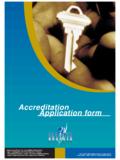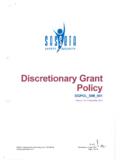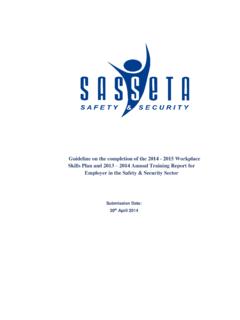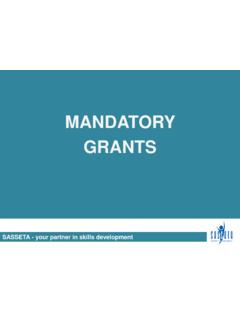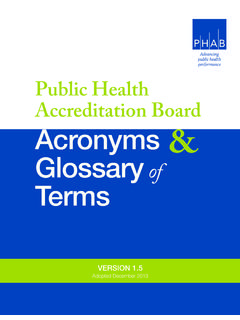Transcription of Table of Contents - Sasseta
1 Table of 1 Purpose of this 2 Section 1: Background to the accreditation development 22. The SETAs .. Skills Learnerships and skills Education and training quality assurance (ETQA).. and the roles of the SETA 7 Section 2: What is Sasseta s approach to to the accreditation What is accreditation?.. What is the value of Scope and primary focus of Sasseta accreditation and related legislation and of Levels of accreditation offered by the Categories of provider Responsibilities of Provider 14 Section 3: Accreditation 15 Section 4: What needs to be of the accreditation Step 1: Application Step 2: The site Step 3: Accreditation and provisional accreditation Step 4: Monitoring Step 5: Step 6: Application for extension of De-accreditation of 32 Section 5.
2 33i= Self-evaluation= InformationiiAcronymsABETA dult Basic Education and TrainingCAWUC onstruction and Allied Workers UnionCCFOC ritical Cross Field OutcomesCIDBC onstruction Industry Development BoardCOSATUC ongress of South African Trade UnionsCETAC onstruction Industry Sector Education & Training AuthorityDoEDepartment of EducationDoLDepartment of LabourDPWD epartment of Public WorksEEAE mployment Equity ActETDPE ducation and Training Development Practitioner/PracticesETDP SETAE ducation, Training and Development Practices SETAETQAE ducation and Training Quality Assurance BodyFETF urther Education and Training (NQF Levels 2 4)FETCF urther Education and Training CertificatesFETQAF urther Education and Training Quality Assurance BodyGETG eneral Education and Training (ABET, NQF, Lev 1, Std 4)GETCG eneral Education and Training CertificateHEQCH igher Education Qualifications CouncilHETH igher Education and Training (NQF Levels 5 8)
3 M&EMonitoring and EvaluationMOUM emorandum of UnderstandingNLRDN ational Learner Record DatabaseNQFN ational Qualifications FrameworkNSAN ational Skills AuthorityNSBN ational Standard BodiesNSDSN ational Skills Development StrategyNSFN ational Skills FundNTCN ational Technical CertificateOBEO utcomes Based EducationOBETO utcomes Based Education and TrainingPDIP reviously Disadvantaged IndividualPOEP ortfolio of EvidenceSASSETAS afety and Security Sector Education and Training AuthorityQALAQ uality Assurance of Learner AchievementsQMSQ uality Management SystemRPLR ecognition of Prior LearningSADTUS outh African Democratic Teachers UnionSAQAS outh African Qualifications AuthoritySAQAAS outh African Qualifications Authority ActSARSS outh African Revenue ServiceSDAS kills Development ActSDCS kills Development CommitteeSDFS kills Development FacilitatorSDLS kills Development LevySDLAS kills Development Levies ActSDPUS kills Development Planning UnitSDSS kills Development StrategySETAS ector Education and Training AuthoritySGBS tandard Generating BodySIRAP rivate Security Industry Regulatory AuthoritySMES ubject Matter ExpertSMMES mall Medium and Micro EnterprisesSSPS ector Skills PlanWPAW orkplace AssessmentWSPW orkplace Skills PlanThis is a fourth edition September 20051 The Sector Education and Training Authority for.
4 Legal Investigation and Private Security Policing Correctional Services Justice National Intelligence Agency South African Secret Service Department of DefencePurpose of this manualThis manual is aimed at assisting providers to become accredited with the highlights: Background to the skills development strategy and the National Qualifications Framework; An overview of the Sasseta s approach to accreditation; The types of accreditation options that are possible; The Sasseta criteria for accreditation; Some pointers for what a provider can do to meet these criteria; and What steps you, as a provider, should take to become accredited (the diagram below provides an overview ofthe accreditation process).Please note: The approximate timeframes indicated above are based on both activities to be undertaken by the ETQAand the provider.
5 Delays in the submission of relevant documentation by the provider will impact on these 1: Background to the accreditation processThis manual focuses on the accreditation framework of the Sasseta ETQA. However, before engaging with thecomplexities of this system, it may be useful to remind yourself of some of the rationales for the accreditation system,and the legislative and policy environment that shapes the priorities inherent in this Skills development strategyThe objectives of theNational Skills Development Strategy (NSDS)are articulated inSkills for productive citizenshipfor all (April 2001-March 2005)which is a strategy that is underpinned by a number of key learning; of equity; skills provision; and decentralisation.
6 And co-operation at a national, sectoral, provincial, community and workplace Sector Education and Training Authority for: Legal Investigation and Private Security Policing Correctional Services Justice National Intelligence Agency South African Secret Service Department of Defence5 Weeks4 WeeksVariableEvery Five YearsOngoing2 WeeksOverview of the accreditation processThese principles are outlined in more detail in the Table IndicatorsDeveloping a culture of high qualitylifelong learning. By March 2005, 70% of all workers have a Level One qualification onthe NQF By March 2005, a minimum of 15% of workers to have embarked ona structured skills development programme, of which 50% haveompleted their programme satisfactorily By March 2005, an average of 20 enterprises per sector and at leastfive national government departments to be committed to, or haveachieved an agreed national standard for enterprise based peopledevelopmentFostering skills development in the formaleconomy for productivity and employmentgrowth By March 2005.
7 At least 75% of enterprises with more than 150workers are receiving skills development grants and the contributiontowards productivity and employability is measured By March 2001 at least 40% of enterprises employing between 50and 150 workers are receiving skills development grants and thecontribution towards productivity and employability is measured By March 2005, learnerships are available to workers in everysector (precise targets will be agreed with each SETA) By March 2005 all government departments assess and report onbudgeted expenditure for skills development relevant to PublicSector, Sector and Departmental prioritiesStimulating and supporting skillsdevelopment in small businesses By March 2005, at least 20% of new and existing registered smallbusinesses to be supported in skills development initiativesPromoting skills development foremployability and sustainable livelihoodsthrough social development By March 2003, 100% of the apportionment of the National SkillsFund to social development is spent on viable development projects By March 2005, the impact of the National Skills Fund is measured byproject type and duration, including details of placement rates.
8 Whichshall be at least 70%Assisting new entrants into employment inthe labour market By March 2005, a minimum of 80 000 people under the age of 30have entered learnerships By March 2005, a minimum of 50% of those who have completedlearnerships are employed within six months of completion(employment, self-employment), full-time study or further training orare in a social development objectives are primarily driven by a few key pieces of legislation. These consist of: The Skills Development Act (SDA), (no. 97 of 1998), which aims to address South Africa s skills needs acrossand within the country s social and economic sectors; and The Skills Development Levies Act (SDLA), (no. 9 of 1999), which ensures that industry contributes to the skillsdevelopment strategy in the form of a monthly SDA is designed to link the worlds of education and work, and in so doing, to thefluctuating needs of theeconomy.
9 The SDA aims to develop the South African workforce and to encourage employers to become activecontributors to education and training in the SDA also establishes the requirements for developing learnerships and skills programmes, an important part ofthe National Skills Development Strategy. All 23 SETA s are currently engaged in the process of developing and/orimplementing learnership and skills programmes that address sectoral skills Sector Education and Training Authority for: Legal Investigation and Private Security Policing Correctional Services Justice National Intelligence Agency South African Secret Service Department of DefenceThe purposes of the SDA, as expressed in the legislation are.
10 To develop the skills of the South African workforceTo improve the quality life of workers, their prospects of work and labour mobilityTo improve productivity in the workplace and competitiveness of employersTo promote self-employmentTo encourage employersTo use the workplace as an active learning environmentTo provide employees with the opportunities to acquire new skillsTo provide opportunities for new entrants to the labour marketTo employ persons whofind it difficult to be employedTo encourage workers to participate in learnerships and other training programmesTo improve the employment prospects of persons previously disadvantaged by unfair discrimination and to redressthose disadvantages through education and SDA made provision for the establishment of the National Skills Authority (NSA)

